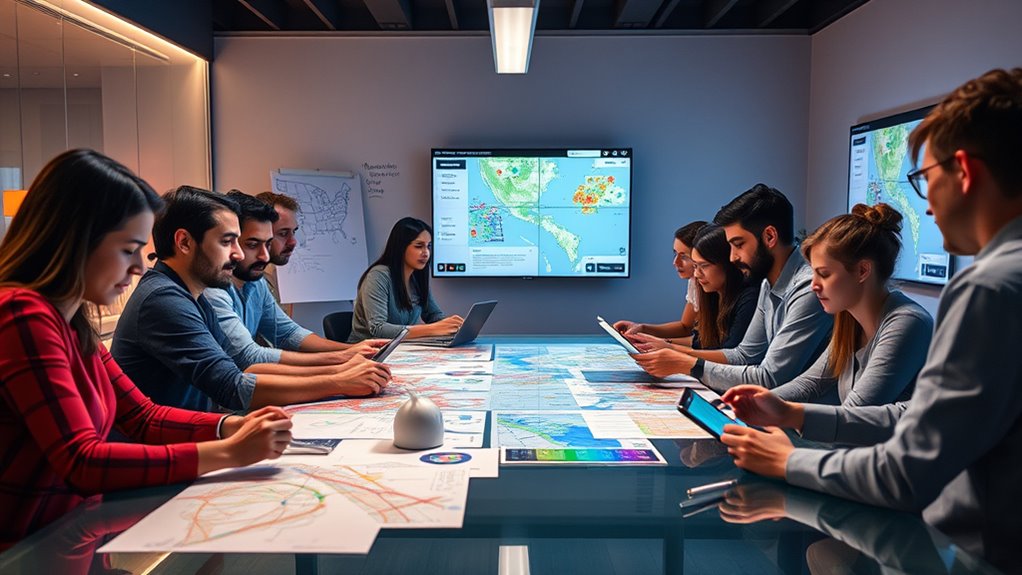Many start-ups are developing disaster warning apps that use community engagement and advanced technology to deliver timely, personalized alerts. They incorporate multiple channels like SMS, social media, and GPS to guarantee alerts reach everyone accurately and quickly. These innovations aim to improve response times, reduce panic, and foster community resilience. By focusing on regional needs and inclusivity, these solutions are transforming emergency alerts. Keep going to discover more about how these apps are making a difference.
Key Takeaways
- Many start-ups focus on leveraging community engagement and local partnerships to develop tailored disaster warning solutions.
- Innovative startups integrate multiple communication channels like SMS, social media, and wearable devices for broader alert delivery.
- Several emerging companies utilize GPS and real-time data to deliver location-specific, personalized disaster alerts.
- Start-ups are incorporating multilingual, accessibility, and real-time hazard reporting features to enhance alert inclusivity.
- New ventures aim to improve alert reliability, responsiveness, and user trust through high refresh rates and integrated data sources.

Have you ever wondered how technology can save lives during emergencies? Start-ups are stepping up by developing disaster warning apps that leverage community engagement and seamless technology integration. These innovative solutions aim to provide timely alerts, ensuring people receive critical information before disaster strikes. As someone who relies on timely updates, you’ll find these apps are designed to bridge gaps in traditional warning systems, making them more accessible and effective.
Community engagement plays a crucial role in the success of these apps. Start-ups recognize that the best way to reach diverse populations is to involve local communities directly. They often collaborate with community leaders, local organizations, and residents to understand specific needs and tailor alerts accordingly. This approach fosters trust and encourages active participation, increasing the likelihood that warnings are received and acted upon promptly. For example, some apps incorporate community feedback features, allowing users to report hazards or share real-time observations, which can be invaluable during fast-developing emergencies. By empowering communities to take ownership of disaster preparedness, these apps create a more resilient network that can adapt to unique regional challenges.
Community involvement enhances disaster alerts, fostering trust and resilience through local feedback and collaboration.
Technology integration is at the core of these start-ups’ innovations. They utilize multiple channels—such as smartphones, SMS, social media, and even wearable devices—to deliver alerts swiftly and reliably. Many apps incorporate GPS technology, enabling precise location-based notifications. This means you won’t receive generic warnings but tailored updates relevant to your exact whereabouts. Additionally, these apps often integrate with existing emergency services and weather data sources, creating a unified platform that consolidates essential information. This integration minimizes delays, ensuring alerts are accurate and delivered in real-time. Push notifications, sound alarms, and visual cues work together to grab your attention, even when you’re not actively using the app. Some startups go further by including multilingual support and accessibility features, ensuring that language barriers or disabilities don’t prevent you from receiving life-saving information. Moreover, incorporating high refresh rates can enhance the clarity and responsiveness of visual alerts, making critical warnings more noticeable and effective.
The combination of community engagement and technology integration makes these disaster warning apps powerful tools for protecting lives. They foster a sense of shared responsibility, encouraging users to stay informed and prepared. As start-ups continue to innovate, you can expect even smarter, more personalized alerts that adapt to your location and communication preferences. This synergy helps reduce panic, improve response times, and ultimately save lives. By harnessing the power of community insights and advanced technology, these apps are transforming how we respond to disasters—making emergency alerts more reliable, inclusive, and effective. So, the next time a warning pops up on your device, remember that behind it is a cutting-edge effort to keep you safe when it matters most.
Frequently Asked Questions
How Do Startup Apps Ensure Real-Time Alert Accuracy?
You guarantee real-time alert accuracy by integrating reliable data sources and using alert verification processes to confirm information before sending out notifications. Protect user privacy by implementing secure data handling and encryption. Continuously monitor and update algorithms to improve precision, and incorporate user feedback to reduce false alarms. This way, you deliver timely, accurate warnings while respecting users’ privacy and maintaining trust in your disaster alert app.
What Are the Main Challenges in Deploying These Apps Globally?
You might think going global is smooth sailing, but cultural barriers and infrastructure disparities make it tricky. Ironically, the biggest challenge is convincing diverse communities to trust and rely on your alerts. You’ll face language differences, varying tech access, and inconsistent communication networks. Overcoming these hurdles demands tailored solutions, local partnerships, and a deep understanding of each region’s unique needs—otherwise, your warning system risks falling silent when it’s needed most.
How Is User Privacy Protected With Location-Based Alerts?
You protect user privacy by implementing data encryption, ensuring location data is secure during transmission and storage. Consent management is also essential; you ask users explicitly for permission before accessing their location, and they can revoke it anytime. By combining these practices, you respect user privacy while delivering effective location-based alerts, fostering trust and compliance with privacy regulations.
What Partnerships Are Essential for Disaster Warning App Success?
You need strong partnerships for disaster warning app success. Collaborating with government agencies ensures emergency response coordination, while partnerships with tech firms enable seamless data sharing. Think of it as a balance—trusting organizations with critical data without compromising privacy. These alliances help you deliver accurate alerts quickly, making your app an essential tool during crises. Without such collaborations, your app risks falling short when it matters most.
How Do Startups Monetize Disaster Warning Applications?
You can monetize disaster warning apps by offering premium features, such as real-time alerts, detailed forecasts, or offline access, which users pay for. Additionally, you can generate revenue through sponsored alerts from trusted partners like emergency services or insurance companies. This way, you provide valuable, targeted information while creating a sustainable business model that benefits both users and partners.
Conclusion
As you explore these innovative start-ups, imagine a world where technology is your shield, swiftly alerting you amidst chaos. While the apps are small, their impact is mighty—standing between you and disaster like vigilant guardians. In a landscape of unpredictability, these tools transform uncertainty into safety, turning the chaos of a storm into a moment of preparedness. You hold the power to stay informed, protected, and ready—thanks to the brave minds behind these lifesaving innovations.









